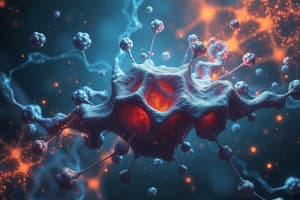Podcast
Questions and Answers
What are found in the nucleus of an atom?
What are found in the nucleus of an atom?
- Cations and Anions
- Protons and Neutrons (correct)
- Electrons and Protons
- Electrons and Neutrons
What is the negatively charged particle of an atom?
What is the negatively charged particle of an atom?
- Molecule
- Neutron
- Protons
- Electrons (correct)
What is the positively charged particle of an atom?
What is the positively charged particle of an atom?
- Neutron
- Molecule
- Protons (correct)
- Electrons
What is the particle of an atom that has no electrical charge?
What is the particle of an atom that has no electrical charge?
The word 'atom' comes from Greek 'Atomos' which means what?
The word 'atom' comes from Greek 'Atomos' which means what?
Who was the first person to propose that atoms have weights?
Who was the first person to propose that atoms have weights?
What is the total number of electrons in a neutral carbon atom?
What is the total number of electrons in a neutral carbon atom?
In an atom, the number of protons is also known as the:
In an atom, the number of protons is also known as the:
Which subatomic particle is responsible for chemical bonding?
Which subatomic particle is responsible for chemical bonding?
What is the total number of neutrons in a neutral helium atom?
What is the total number of neutrons in a neutral helium atom?
Who discovered the electron?
Who discovered the electron?
What is a substance that cannot be broken down into simpler substances?
What is a substance that cannot be broken down into simpler substances?
What is the result of the combination of two or more elements in definite proportion of mass?
What is the result of the combination of two or more elements in definite proportion of mass?
Which classification includes suspension, colloids, or solutions?
Which classification includes suspension, colloids, or solutions?
What is an example of a homogeneous mixture?
What is an example of a homogeneous mixture?
Who discovered the neutron?
Who discovered the neutron?
What is anything that occupies space and has mass?
What is anything that occupies space and has mass?
Which scientist discovered the proton?
Which scientist discovered the proton?
What are the three states of matter?
What are the three states of matter?
What is an example of a suspension?
What is an example of a suspension?
Which of the following is NOT an intensive property of a material?
Which of the following is NOT an intensive property of a material?
Who formulated the atomic theory?
Who formulated the atomic theory?
What is the unit for the charge of a particle?
What is the unit for the charge of a particle?
What is the charge of an electron in coulombs?
What is the charge of an electron in coulombs?
What is the charge of an electron in charge units?
What is the charge of an electron in charge units?
The discovery of radioactivity further confirms the existence of subatomic particles. Who discovered radioactivity?
The discovery of radioactivity further confirms the existence of subatomic particles. Who discovered radioactivity?
Which of the following is NOT an extensive property of a material?
Which of the following is NOT an extensive property of a material?
How does Joseph John Thomson call his model of the atom?
How does Joseph John Thomson call his model of the atom?
Who revised the atomic theory by replacing the hard, indestructible spheres imagined by Dalton and proposed the 'raisin bread model' of the atom?
Who revised the atomic theory by replacing the hard, indestructible spheres imagined by Dalton and proposed the 'raisin bread model' of the atom?
The properties of a material that do not change when the amount of substance changes are called _______ properties.
The properties of a material that do not change when the amount of substance changes are called _______ properties.
Flashcards are hidden until you start studying
Study Notes
Chemistry Basics Summary
- Joseph John Thomson discovered the electron
- Ernest Rutherford discovered the proton
- James Chadwick discovered the neutron
- Matter is anything that occupies space and has mass
- All forms of matter are composed of atoms
- Substances are classified as elements or compounds
- An element is a substance that cannot be broken down into simpler substances
- A compound results from the combination of two or more elements in definite proportion of mass
- Mixtures are classified as suspension, colloids, or solutions
- Soil and water is an example of a suspension
- A homogeneous mixture of sugar dispersed in water is called a solution
- The three states of matter are solid, liquid, and gas
Studying That Suits You
Use AI to generate personalized quizzes and flashcards to suit your learning preferences.




